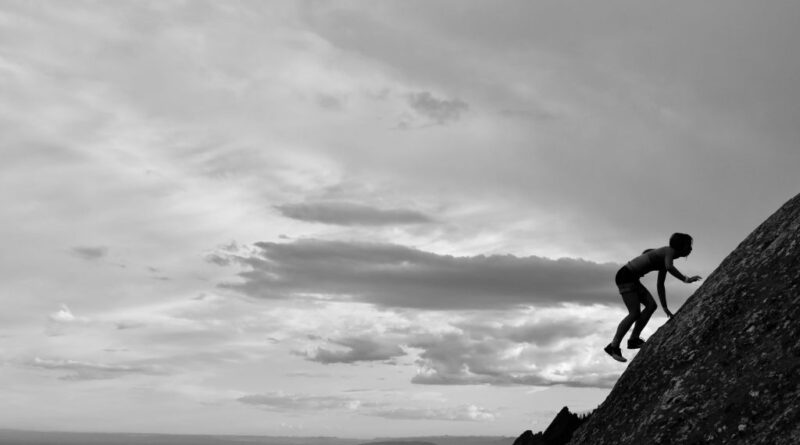Fatal fall exposes the risk rock-scramblers take by not using ropes
A well-known Boulder climbing club that specializes in quick and rope-free ascents of Boulder’s famous tilted Flatirons has been jolted by the death of a member who fell 500 feet to her death in Rocky Mountain National Park last week.
Bailee Mulholland, 26, was on Blitzen Ridge on Ypsilon Mountain, a jagged, but relatively easy climb, according to experienced rock scramblers, but one that highlights the risks climbers take while scrambling — or “free soloing” — on routes with steep faces and extreme exposures.
“This is hitting our group pretty hard,” said Bill Wright, the founder of Satan’s Minions, the club that Mulholland belonged to. “We don’t promote this stuff, we don’t recruit people. We’re a group that does this stuff, we love this stuff and we know it’s potentially super dangerous because you don’t have a rope. It’s a tough line to walk because we’re up there for fun. We’re not trying to be daredevils. She wasn’t trying to be a daredevil. This climb was quite an easy climb.”
What she was doing — what all of the 100 or so members of the club specialize in — is different than ascending straight up the side of the mountain, which is what many people think of when they imagine rock climbing. Scrambling means negotiating rocky crags, usually on an angle, without using ropes to protect against falls. The terrain where she fell was not highly technical.
“She didn’t climb up a face that was 500 feet. She scrambled up stuff that’s more like hiking than scrambling, and then she goes across this ridge which is 500 feet tall. So she didn’t solo up some giant vertical 500-foot face,” Wright explained.
Like many club members, Mulholland frequently scrambled up the Flatirons before work as part of her morning routine. Wright would often see her when he was there doing the same thing. “She was…super positive and really excited to learn and get better.”
Michael Reese, another club member who often begins his days running up the Flatirons, said Mulholland was the best female scrambler in Boulder.
“That’s what made [her death] especially shocking,” Reese said. “We’ve been talking a lot about it in the community and the scrambling club. Her ability far exceeded what was needed to climb the route she was doing. When something like this happens, it makes everyone take a look and realize the risks never go to zero.”
According to the Boulder Daily Camera, Mulholland was born in China before being adopted, and she grew up in Boulder where she was attracted to running and playing the violin. After graduating from the University of Colorado, she became a software engineer and ultrarunner.
Running led her into the scrambling subculture that thrives on scampering up the Flatirons. Boulder is known for world-class runners and fabled rock climbs in Eldorado Canyon, Boulder Canyon and the Flatirons, so the connection comes naturally.
“In our group, we have two kinds of people, runners who climb and climbers who run,” Wright said. “The climbers who run are the safest. They’ve probably taken falls with ropes. They know the consequences. They’re much more precise with their feet because they’re coming from rock climbing, where you have to be very precise to climb hard stuff.”
To weed out those who don’t fully respect the consequences of scrambling up Flatirons angled at 50 to 60 degrees without protection, the club requires that new members pass qualification standards. The final test is an “interview scramble” with Wright observing nearby, scrutinizing every move. If prospective members make him nervous, they aren’t allowed to join.
“She was a runner who climbed, but she had gotten to be a very good rock climber,” Wright said. “She did a lot of rock climbing, and that really helped her scrambling, being really solid and really safe. Well, it’s hard to justify saying ‘really safe,’ because what we do is not safe, but to do enough practice and get enough laps on things that we may get safe enough.”
The day after Mulholland’s death, a climber scrambling near the top of the First Flatiron fell 100 feet before landing on a ledge and was seriously injured, according to the Boulder County Sheriff’s Office. That person had to be evacuated by rescue crews.
For some, the attraction of scrambling is the challenge of speed. Reese holds three speed records in the Flatirons and is training now in hopes of breaking the speed record on Half Dome in Yosemite National Park. For others, it’s about the ability to climb “light,” unencumbered by heavy equipment.
Scrambling is essentially the same as free soloing, which became a hot topic in 2017 when Alex Honnold free soloed a 2,900-foot route on Yosemite’s vertical El Capitan. Scrambling of the kind practiced by Satan’s Minions is lower angled, although the consequences of a mistake can be the same.
“There’s no thought of cheating death or doing anything like Alex Honnold does,” Wright said. “The mindset of our group is not that at all, it’s just to go out and enjoy these beautiful structures. We’re not trying to push the limits of difficulty, we’re trying to scramble stuff.”
They all know they can’t afford to fall, though.
“At the end of the day, there’s always that risk, even for someone experienced,” Reese said. “The scrambling people do, probably the majority of it, a fall would be fatal on the Flatirons.”
Wright said Mulholland didn’t mind the risks.
“It was in her blood, and I think she found her calling when she discovered scrambling and climbing,” Wright said. “She was already a runner, but this was a whole new world for her. She loved it and she was going hard into it. She had a lot of talent. And so positive, endlessly positive. Always smiling and just loving life.”
Subscribe to our weekly newsletter, The Adventurist, to get outdoors news sent straight to your inbox.
Source: Read Full Article




